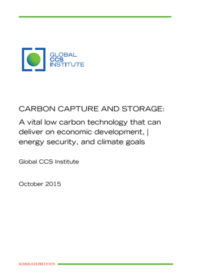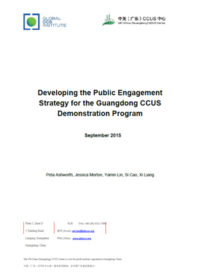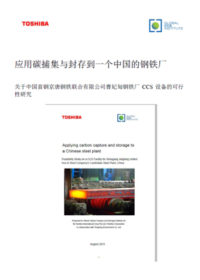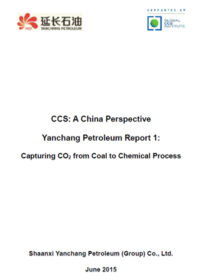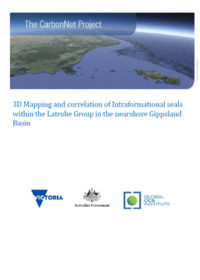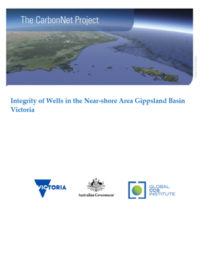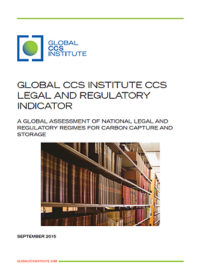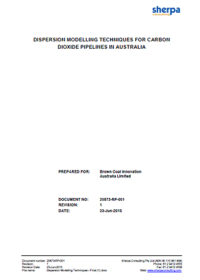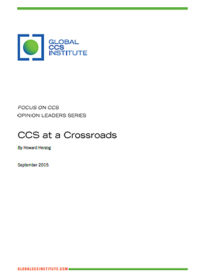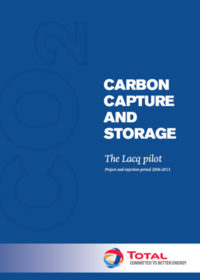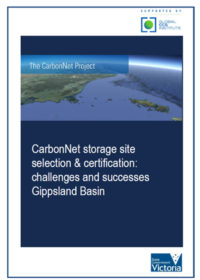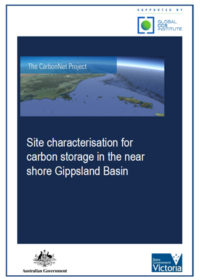Resources
Publications
Our publications, reports and research library hosts over 500 specialist reports and research papers on all topics associated with CCS.
View our Publication Library Disclaimer.
Filter by
Carbon capture and storage: a vital low carbon technology that can deliver on economic development, energy security, and climate goals
2nd November 2015
Topic(s): Carbon capture use and storage (CCUS), Policy law and regulation
The Global CCS Institute’s Senior Advisor Policy & Regulatory, Pamela Tomski, suggests recommendations for policy makers to consider to accelerate the commercial deployment of CCS.
CCS, as a part of a portfolio of low carbon emissions technologies, can deliver on climate goals and in many countries simultaneously meet energy security and sustainable economic development goals.
Disclaimer
The content within the Global CCS Institute Publications, Reports and Research Library is provided for information purposes only. We make every effort and take reasonable care to keep the content of this section up-to-date and error-free. However, we make no claim as to its accuracy, currency or reliability.
Content and material featured within this section of our website includes reports and research published by third parties. The content and material may include opinions and recommendations of third parties that do not reflect those held by the Global CCS Institute.
Developing the public engagement strategy for the Guangdong CCUS Demonstration Program
29th October 2015
Topic(s): Carbon capture use and storage (CCUS), Public engagement
The Global CCS Institute and the UK-China (Guangdong) CCUS Centre have authored this report to document the process that has been undertaken by the China Resources Power (Haifeng) and China National Offshore Oil Corporation (CNOOC) Integrated Carbon Capture and Sequestration Demonstration Project (CRP Power Project) to develop a public engagement strategy for the project.
This undertaking is the first of its kind in China and is an ongoing journey.To date, the majority of CCS public engagement project case studies have analysed activity that has taken place in Europe, North America and Australia. An important next step is to reflect on how current best practice may apply in other regional contexts. The experiences and lessons learned by the CRP Power Project may be useful to other CCS project proponents in China who are considering the development of a public engagement strategy.
This report is authored by Peta Ashworth (Ash Research), Jessica Morton (Global CCS Institute), Yamin Lin and Si Cao (Nafang Media) and Xi Liang (UK-China (Guangdong) CCUS Centre). The authors would like to acknowledge the strategic advice and input from Qianguo Lin (Global CCS Institute) and Dr David Reiner (Judge Business School, Cambridge University).
Jessica Morton, the Institute’s Public Engagement Advisor Asia-Pacific has written an Insight that provides an overview of this report and other recent CCS public engagement activities in the Asia Pacific region.
Disclaimer
The content within the Global CCS Institute Publications, Reports and Research Library is provided for information purposes only. We make every effort and take reasonable care to keep the content of this section up-to-date and error-free. However, we make no claim as to its accuracy, currency or reliability.
Content and material featured within this section of our website includes reports and research published by third parties. The content and material may include opinions and recommendations of third parties that do not reflect those held by the Global CCS Institute.
应用碳捕集与封存到一个中国的钢铁厂。关于中国首钢京唐钢铁联合有限公司曹妃甸钢铁厂CCS 设备的可行性研究
27th October 2015
Topic(s): Carbon capture use and storage (CCUS), Engineering and project delivery
全球碳捕集与封存研究院在此发布《在中国钢铁厂进行碳捕集与封存的可研报告》。东芝公司承担了该项可研工作,项目通过东芝的商业合作伙伴同方环境与首钢京唐钢铁厂合作进行。本可研对在曹妃甸钢厂的进行碳捕集与封存项目的可行性进行了论证。该报告探讨了在中国钢铁厂进行碳捕集、运输和可能的封存和二氧化碳采油这一概念。该报告认为,与世界其它地方的类似钢厂相比较,在中国钢铁厂进行碳捕集是一种有成本竞争力的碳减排手段。
该报告由东芝公司为全球碳捕集与封存研究院完成。全球碳捕集与封存研究院的亚太区高级碳捕集顾问Tony Zhang博士同时也在全球碳捕集与封存研究院网站上发布了关于该报告的总结讲解。
Chinese translation of Applying carbon capture and storage to a Chinese steel plant.
Disclaimer
The content within the Global CCS Institute Publications, Reports and Research Library is provided for information purposes only. We make every effort and take reasonable care to keep the content of this section up-to-date and error-free. However, we make no claim as to its accuracy, currency or reliability.
Content and material featured within this section of our website includes reports and research published by third parties. The content and material may include opinions and recommendations of third parties that do not reflect those held by the Global CCS Institute.
Yanchang Petroleum report 1: capturing CO2 from coal to chemical process
16th October 2015
Topic(s): Carbon capture use and storage (CCUS), CO2 capture
To promote the development of CCS in China, the Global CCS Institute and China National Development and Reform Commission (NDRC) held a joint carbon capture, utilisation and storage (CCUS) workshop in Yan’An China in July 2013. Out of this collaboration the Global CCS Institute has commissioned Yanchang Petroleum Group to produce four knowledge-sharing reports on its integrated CCS project.
This first report of the series discusses the capture aspects of Yanchang Petroleum CCUS Project. It highlights project achievements and lessons learned from the project.
Tony Zhang, Institute Senior Adviser for Capture, Asia-Pacific provides an overview of this report in an Insight available on the Global CCS Institute website.
Disclaimer
The content within the Global CCS Institute Publications, Reports and Research Library is provided for information purposes only. We make every effort and take reasonable care to keep the content of this section up-to-date and error-free. However, we make no claim as to its accuracy, currency or reliability.
Content and material featured within this section of our website includes reports and research published by third parties. The content and material may include opinions and recommendations of third parties that do not reflect those held by the Global CCS Institute.
The CarbonNet Project: 3D mapping and correlation of intraformational seals within the Latrobe Group in the nearshore Gippsland Basin
15th October 2015
Topic(s): Carbon capture use and storage (CCUS), CO2 storage
The Global CCS Institute presents the sixth report published by the CarbonNet Project, located in Victoria, Australia, this report has focussed on a critical aspect of CO2 storage - containment of the CO2. CarbonNet are investigating the potential for establishing a large scale, multi user CCS network bringing together multiple CO2 capture projects, transporting CO2 via a shared pipeline and injecting it deep into an underground, offshore storage site and is currently in feasibility and commercial definition stage.
The Gippsland Basin is known to have a world-class proven regional seal (or caprocks), known as the Lakes Entrance Formation it has stored oil and gas accumulations for tens of millions of years. This regional seal has always been identified as the final barrier to CO2 plume migration in any storage concept in the basin. This report has identified several additional, laterally extensive seals below the regional seal, known as the T2 seal. These additional sealing units are expected to provide an effective barrier to the CO2 injected into the primary storage targets below in the Halibut reservoirs. The T2 seals are proven to be effective containment rocks as they have previously retained oil and gas accumulations locally and nearby. Also, lab measurements on rock samples of the seal suggest they could hold back a column of CO2 in excess of what is expected to be required in the reservoirs below. This investigation has revealed there may be hundreds of gigatonnes of additional storage available and confirms that the Gippsland Basin is a world class storage site for CCS.
This report is authored by N. Hoffman , T. Evans, N. Arian, The CarbonNet Project, Melbourne, Australia; Guy Holdgate, University of Melbourne. Chris Consoli, Institute Senior Adviser for Storage, Asia-Pacific also provides an overview of the report in an Insight available on the Global CCS Institute website.
Disclaimer
The content within the Global CCS Institute Publications, Reports and Research Library is provided for information purposes only. We make every effort and take reasonable care to keep the content of this section up-to-date and error-free. However, we make no claim as to its accuracy, currency or reliability.
Content and material featured within this section of our website includes reports and research published by third parties. The content and material may include opinions and recommendations of third parties that do not reflect those held by the Global CCS Institute.
The CarbonNet Project: integrity of wells in the near-shore area Gippsland Basin Victoria
14th October 2015
Topic(s): Carbon capture use and storage (CCUS), CO2 storage
The Global CCS Institute presents this new report by CarbonNet evaluating the impact legacy petroleum wells may have on their search for CO2 storage sites in the nearshore Gippsland Basin. The CarbonNet Project is investigating the potential to establish a CCS Hub bringing together multiple CO2 capture projects in Victoria’s Latrobe Valley, transporting CO2 via a shared pipeline and injecting it into deep saline formations in the nearshore Gippsland Basin.
This report identified and then analysed legacy petroleum wells that may have an impact on the feasibility of CO2 storage sites targeted as future storage concepts. The analysis included using data lodged with the regulatory authority to assess how the legacy petroleum wells were ‘completed’. The investigation found that none of the wells have any significant risk of leakage and that there is negligible risk of CO2 rising to near-surface levels.
This report is authored by Todd Goebel, Nick Hoffman, Barry Nicholson, and The CarbonNet Project. Chris Consoli, Institute Senior Adviser for Storage, Asia-Pacific also provides an overview of the report in a new Insight available on the Global CCS Institute website.
Disclaimer
The content within the Global CCS Institute Publications, Reports and Research Library is provided for information purposes only. We make every effort and take reasonable care to keep the content of this section up-to-date and error-free. However, we make no claim as to its accuracy, currency or reliability.
Content and material featured within this section of our website includes reports and research published by third parties. The content and material may include opinions and recommendations of third parties that do not reflect those held by the Global CCS Institute.
Global CCS Institute CCS legal and regulatory indicator
29th September 2015
Topic(s): Carbon capture use and storage (CCUS), Policy law and regulation
The Institute’s CCS Legal and Regulatory Indicator represents a detailed examination and assessment of 55 countries’ legal and regulatory frameworks for the technology. The Indicator considers a broad range of legal and regulatory factors, which are likely to be critical to the regulation of CCS, and it is hoped that it will prove a valuable model for tracking progress and opportunities for the development of legal frameworks worldwide.
Disclaimer
The content within the Global CCS Institute Publications, Reports and Research Library is provided for information purposes only. We make every effort and take reasonable care to keep the content of this section up-to-date and error-free. However, we make no claim as to its accuracy, currency or reliability.
Content and material featured within this section of our website includes reports and research published by third parties. The content and material may include opinions and recommendations of third parties that do not reflect those held by the Global CCS Institute.
Dispersion modelling techniques for carbon dioxide pipelines in Australia
23rd September 2015
Topic(s): Carbon capture use and storage (CCUS), CO2 transport
The Global CCS Institute presents the first detailed report on CO2 pipeline design for Australia. This comprehensive investigation provides a critical review of current Australian and global pipeline design standards for CO2 transport. The report provides insight into the current Australian Standards for Pipeline Design, AS2885 and undertaking fit-for-purpose dispersion modeling for CO2 detailing a set of guidelines and best practice recommendations.
The report was prepared for Brown Coal Innovation by Sherpa Consulting and funded by the Australian National Low Emissions Coal Research and Development Ltd (ANLEC R&D) and the Department of Economic Development, Jobs, Transport, and Resources of the State of Victoria, administered through Brown Coal Innovation Australia Limited and is part of the series of reports focussing on CCS in Victoria.
Chris Consoli, Institute Senior Adviser for Storage, Asia-Pacific also provides an overview of the report in an Insight available on the Global CCS Institute website.
This report is republished with the permission of The CarbonNet Project. It was funded in part by a contribution by the Global CCS Institute, commissioned within the scope of The CarbonNet Project and in line with The Institute's mission to accelerate the development, demonstration and deployment of carbon capture and storage globally. The views expressed within the report are those of the authors and not necessarily of the Global CCS Institute.
Disclaimer
The content within the Global CCS Institute Publications, Reports and Research Library is provided for information purposes only. We make every effort and take reasonable care to keep the content of this section up-to-date and error-free. However, we make no claim as to its accuracy, currency or reliability.
Content and material featured within this section of our website includes reports and research published by third parties. The content and material may include opinions and recommendations of third parties that do not reflect those held by the Global CCS Institute.
CCS at a crossroads
23rd September 2015
Topic(s): Carbon capture use and storage (CCUS), Economics, Policy law and regulation
Howard Herzog's article, CCS at a crossroads, is part of an opinion leader’s article series for Focus on CCS. The series features contributions from world leading authorities on carbon capture and storage (CCS), presenting their perspectives on the role for the technology in reducing our carbon dioxide emissions. The series is published by the Global CCS Institute to contribute to the conversation about CCS within the portfolio of options to help tackle climate change.
Howard J. Herzog is a Senior Research Engineer in the MIT Energy Initiative.
Disclaimer
The content within the Global CCS Institute Publications, Reports and Research Library is provided for information purposes only. We make every effort and take reasonable care to keep the content of this section up-to-date and error-free. However, we make no claim as to its accuracy, currency or reliability.
Content and material featured within this section of our website includes reports and research published by third parties. The content and material may include opinions and recommendations of third parties that do not reflect those held by the Global CCS Institute.
Carbon capture and storage: the Lacq pilot. Project and injection period 2006-2013
15th September 2015
Topic(s): Carbon capture use and storage (CCUS), Engineering and project delivery
This publication describes Total’s Lacq CCS pilot demonstration project. The pilot project entailed the conversion of an existing air-fired boiler to a 30 MWth oxy-combustion boiler that produced a flue gas with a high CO2 content. The project’s aim was to test the complete chain of capture, transport and storage of purified and compressed CO2, integrated within the infrastructure of the Lacq industrial platform.
The publication includes technical and geological content, environmental impact and risk assessments, monitoring and surveillance data, and a discussion on community outreach. It provides insights for those involved in developing CCS in the future.
Disclaimer
The content within the Global CCS Institute Publications, Reports and Research Library is provided for information purposes only. We make every effort and take reasonable care to keep the content of this section up-to-date and error-free. However, we make no claim as to its accuracy, currency or reliability.
Content and material featured within this section of our website includes reports and research published by third parties. The content and material may include opinions and recommendations of third parties that do not reflect those held by the Global CCS Institute.
The CarbonNet Project. CarbonNet storage site selection & certification: challenges and successes
14th September 2015
Topic(s): Carbon capture use and storage (CCUS), CO2 hubs, CO2 storage
The Global CCS Institute presents the second report by CarbonNet to identify and then characterise suitable storage sites in the offshore Gippsland Basin. The CarbonNet Project is investigating the potential to establish a CCS Hub bringing together multiple CO2 capture projects in Victoria’s Latrobe Valley, transporting CO2 via a shared pipeline and injecting it into the offshore Gippsland Basin.
This report details the history of the site selection process between 2010 and 2015. The search for a storage site has followed international best practice, aligned to DNV GL Recommended Practice (DNV-RP-J203) to provide decision makers and stakeholders with independent expert assurance of environmentally safe, long-term geological storage.
This report is authored by George Carman, Nick Hoffman, and the CarbonNet Project. Chris Consoli, Institute Senior Adviser for Storage, Asia-Pacific also provides an overview of the report in an Insight available on the Global CCS Institute website.
Disclaimer
The content within the Global CCS Institute Publications, Reports and Research Library is provided for information purposes only. We make every effort and take reasonable care to keep the content of this section up-to-date and error-free. However, we make no claim as to its accuracy, currency or reliability.
Content and material featured within this section of our website includes reports and research published by third parties. The content and material may include opinions and recommendations of third parties that do not reflect those held by the Global CCS Institute.
The CarbonNet Project: site characterisation for carbon storage in the near shore Gippsland Basin
7th September 2015
Topic(s): Carbon capture use and storage (CCUS), CO2 storage
The Global CCS Institute presents a carbon dioxide (CO2) storage site characterisation study for the CarbonNet Project. The CarbonNet project is investigating the potential to establish a CCS Hub bringing together multiple CO2 capture projects in Victoria’s Latrobe Valley, transporting CO2 via a shared pipeline and injecting it into the offshore Gippsland Basin. The report details the steps taken during the screening of potential storage sites in the offshore Gippsland Basin.
Three of the highest ranked sites are identified and their geological characteristics detailed and suitability for CO2 storage are described. The report found that all three storage sites are located nearshore and have the potential to dispose of between 25 and 15 Mt of CO2 permanently in deep saline formations.
This report is authored by Nick Hoffman, George Carman, Mohammad Bagheri, Todd Goebel; and the CarbonNet Project for the Global CCS Institute. Chris Consoli, Institute Senior Adviser for Storage, Asia-Pacific also provides an overview of the report in a new Insight available on the Global CCS Institute website.
Disclaimer
The content within the Global CCS Institute Publications, Reports and Research Library is provided for information purposes only. We make every effort and take reasonable care to keep the content of this section up-to-date and error-free. However, we make no claim as to its accuracy, currency or reliability.
Content and material featured within this section of our website includes reports and research published by third parties. The content and material may include opinions and recommendations of third parties that do not reflect those held by the Global CCS Institute.
